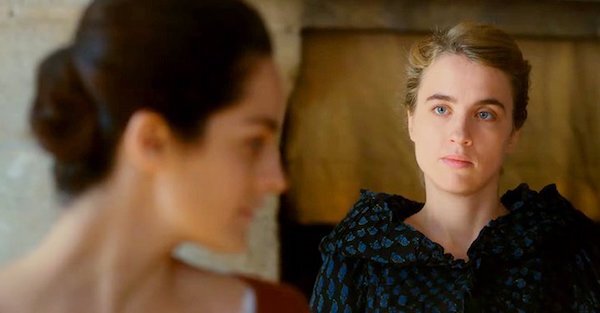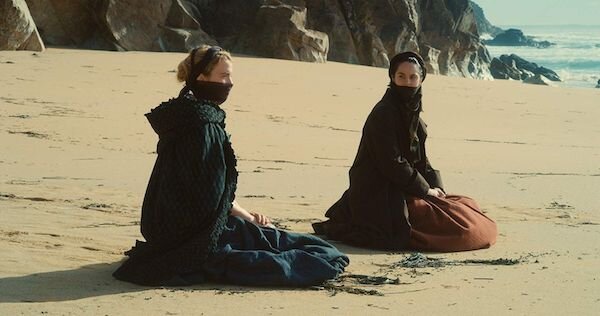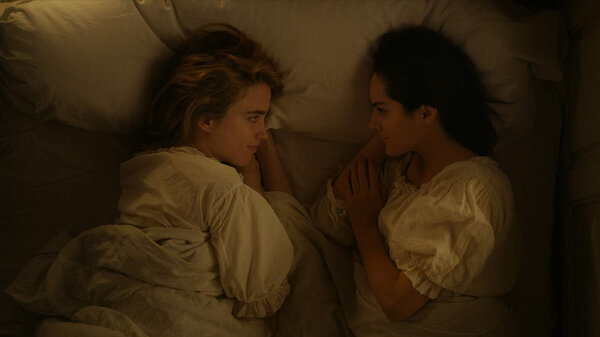Céline Sciamma’s masterful fourth feature frames a lesbian love story with tenderness that feels almost too much to bear. Its specificity is its strength, showing a precise portrait of looking, and seeing through the eyes of love. Savina Petkova looks through her own prism to reveal the personal pain of loving and longing.
It takes me a whole lifetime to rise from my seat after a third viewing of Portrait of a Lady on Fire. Its “non posso fuggire” chant during the end credits weighs me down, renders me immobile, somehow topping the final sequence that steals your breath away with the swipe of a violin bow. I have shared these two hours of screen time with a love story of my own, one that’s already bound to the past, though it’s still left me tongue-tied. We have both looked at the same images, witnessed the same lesbian sex scene, probably even teared up at the same point. Yet I do not know how to talk about it with him. How does one muster the strength to articulate love that is unattainable, after watching a film that proves looks to be a more potent signifier than any word? It was by sharing that same screen, both becoming enamoured in the same exchange of glances, that I could even begin to write this, or talk to him. Céline Sciamma showed me how much I valued seeing and – even more – being seen by my loved one, while Portrait of a Lady on Fire taught me how to address it.
In Portrait of a Lady on Fire, a film composed almost entirely of labyrinthian gazes, a rather paradoxical statement can be distilled. By gazing into another person’s eyes, we see her look, rather than the eyes themselves. Precisely this perplexing thought has led theorists and psychoanalysts, most famously Jacques Lacan, to distinguish between the exchange of a narcissistic look and a structuring, loving look. Romantic clichés tell us of the importance of regarding the other, but there is something entrancingly raw about the way this film makes one feel seen. Portrait of a Lady on Fire is a lesbian love story, as both singular and universal, that is attentive to nuances of lesbian relationships and being in love. A young woman, Héloïse (Adèle Haenel, electrifying) is engaged to be married to a Milanese suitor, only on the condition that her portrait is painted well enough. After refusing to pose for her previous artist, Héloïse is paired with Marianne (Noémie Merlant), who has to paint her in secret under the pretence of providing company for seaside walks. In this depiction of the 18th century period, heteronormativite restrictions (the lesbian romance remains secret) and gender imparity in the art world seem exemplary also of our own times, making the stakes of the film even higher, politically.
Aside from being a testament to the many nameless women painters of the 18th century (and onwards), Portrait of a Lady on Fire couples its motif of shared visibility with artistic labour – both transforming the distance between their objects into intimacy. Such closeness without appropriation resembles a caress that lightly hovers over one’s skin, but does not grasp to hold. It also underlies the gentle kind of revolution Sciamma engages in: dismantling the hierarchical structures that usually delineate artist from muse, or looker from looked at. When Marianne speaks of “rules, conventions, ideas” that make up the way one is seen, and captured – in both painting and film, Héloïse singles them out as opposites of life and presence. “Is that me? Is that how you see me?”, she asks despondently, offended by the first portrait, even more, by Marianne’s failed attempt to see her. And she has failed to do only because of the attempt to look as a painter at her muse, rather than engage in an equal, reciprocal relationship. Sometimes, an overpowering desire to behold the other conceals a narcissistic look, and its mirroring result can mask itself as love. Lacan wrote of the structural value of the “mirror stage” in infants when they first make peace with their specular image, elaborating on its alienating and identifying potential in formation of one’s ego. Like the frustrated Héloïse, I despaired in a lack of recognition. By turning my lover’s eyes into a mirror, I had, in fact, obscured myself, and no affirmative identity followed that gaze into my own reflection. One can miss love either by not looking at all, or by looking too closely. A fixed stare into someone’s eye might make out your own reflection. That's when you know you’re doing it wrong.
During her first night at the chateau, Marianne curiously examines her studio, used as a stock room. While the frame is obstructed by piles and draped furniture, the slow tracking shot follows her as she approaches a painting facing the wall, and in the exact moment of entering the frame and facing the canvas, her silhouette aligns with it completely: a pre-destined togetherness that suggests future equality. As she reaches out to turn the painting, it’s revealed to be damaged, disrupting the illusion of a shared look between two faces. Later, when Marianne wipes off the face of the first finished portrait in sheer anger, it is Héloïse who will arrange herself in a similar position in front of it, this time facing the camera. The film is built on expanding repetitions, like a fugue that takes on its musical motifs and reworks them according to new context. Shot-counter shot composition governs the love relations here, and as conventional as it is in terms of cinematic language, in its function to bridge the distance between one object and another, this communicating device as old as cinema acquires new transformative properties under the masterful command of cinematographer Claire Mathon.
Héloïse remains a faceless, alluring phantom, an abstraction of a woman defined by her future marriage, until the first fated morning walk. At the top of a staircase, the camera assumes Marianne’s point of view as her gaze hovers over a hooded figure in the dim hallway – her madame is waiting. There’s something mystifying in the way Héloïse’s concealed face comes in close contact with bright daylight as she opens the door to exit. Yet, her quick pace allows the frame to engulf her, to form a lingering, misty halo over her embroidered hood – she seems a mythical creature that belongs both to the netherworld and heaven. The visual cues for idolisation are already at work. Marianne’s gaze peels off layers of clothing bit by bit, as Héloïse’s mantle hood slides down, her blonde curls barely held in a chignon, the skin of her arm now visible as she runs toward the sea, as well as the back of her knees – erotic fragments that are dislocated from their sexual potential, yet allude to a possible consumated future. The sound of waves roaring and both women gasping for air form a diegetic symphony that resonates throughout the frame as, finally, our wish has been granted – Héloïse turns around to face the camera, and that image fulminates like lightning.
The first meeting of the two is orchestrated in a visually compelling way, manifesting Marianne’s immense desire. But it is still a desire to see, one that obfuscates the possibility of being seen, that borders idolisation. Portrait of a Lady On Fire channels these perilous tonal shifts and tropes of love through its visual grammar in a way that is contemplative and ruthless at the same time. Often, it is immensely important to look away, so you can let yourself be seen.
Otherwise, your loving gaze could set someone aflame. In a rather mystic sequence of the film, Marianne and Héloïse share a distinct look of equality, consecrated by a fire shimmering between them. A gentle humming transcends the frame as a tracking shot takes its time to make out all the women present, their faces, glances, continuous clapping, and the camera’s motion seems to elicit their chant, “La Jeune Fille En Feu” (gladly now on Spotify). With its three sole words – “non posso fuggire” (“I cannot escape”) – the first musical piece of the film creates a dazed, rapturous experience of ecstasy and rhythm. In such convincing aesthetic homogeneity, when introducing a new trope or figure, the film rethinks and rephrases precisely that previous absence. In music, we think about the silence. In close-ups, we become aware of the fact we’ve been kept at a distance for so long. When we see a man on screen, we realise how lovely it is to dwell in a woman's world. When Marianne and Héloïse reciprocate each other’s gazes on equal terms, we become aware of their previous power dynamics. The flames between them form a transparent veil that actually facilitates seeing, rather than obscuring it, being the source of light in this moonless night. It offers an apt material metaphor for the love burning between the two, or the burning sensation when blood rushes to your cheeks. The fire is a literal mark of an intense, but reciprocated look, a new, purified form of visual compatibility that burns away my defences. How I, too, would have wanted to be seen through fire.
In the 1970s, feminist film theory addressed the primary masculine gaze, which rendered women (especially in Classical Hollywood films) little more than titilating objects for the phallic imaginary. Laura Mulvey wrote of female “to be looked-at-ness”. Deconstructing the immanent discrimination that grounded both the canon and the way we read films, theorists and critics alike have been trying ever since to make differentiation possible on the grounds of gender, race, and sexual orientation. All of Céline Sciamma’s films (particularly Water Lilies, Tomboy, and Girlhood) in their aesthetics as well as through their storytelling address such differences. Her latest film renders the optics of desire tactile, as the spectator’s eyes keep following the looks exchanged between the two. What is visible becomes palpable, and the gaze is no longer an abstract category, nor a momentous exchange that perpetuates inert hierarchies. Portrait of a Lady on Fire submits a claim bolder than any theory or analysis ever could, to be a cinematic stand-alone piece of criticism, dismantling old paradigms and proposing a new one, with the metamorphic potential of the outward-facing female gaze. Its return, on the other hand, paints a horizon of visibility for lovers, artists – and anyone ever been thought unworthy of being seen. The gaze I approached my lover with at the end of the screening was still an unformulated thought. It soared over the surface of his eyes as a statement not yet uttered. For a moment, I found consolation in the perspective of never speaking again and, instead, penning a few words on a lower corner of a page 28. However, it only takes two hours of looking through the eyes of people falling in love, attending to how they look at each other, to take away that love wouldn’t let you slip through the cracks unseen. In a way, visibility is not about the eye at all. It is about the mutual effort of continuously making out the shape of one another, in all their tiny details. As if looking through fire and flames.
Savina Petkova (@savinapetkova) is a film critic/PhD candidate based in London who lives from one film festival to another. She specialises in animal representations in contemporary film and writes for Electric Ghost Magazine and MUBI Notebook.
Our CÉLINE SCIAMMA t-shirt is available to purchase here. Proceeds go towards paying our writers and supporting female-led film projects.








